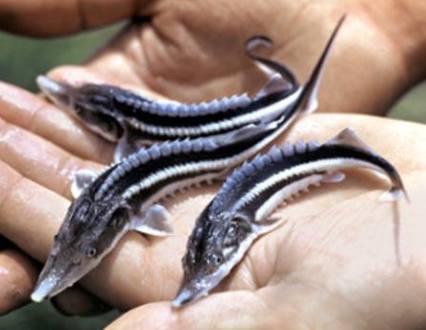Until this morning I assumed that there was only one really big ticket harvest one could grow in any type of hydro system. My bad. There seems to be two. If you love caviar, I’m sure you’re going to find this aquaponics possibility very exciting. It’s a harvest that commands incredibly high market value. In the neighborhood of $8,000 per kilogram.
Pairing aquaponics crops with sturgeon is something pretty new, and obviously exciting. Water Farmers in Toronto just released the announcement of their eggy plans on their Facebook page this week.
Harvesting from wild sturgeons fish is pretty much outlawed on a global basis, because the world population of all species of this fish has reached numbers that lean toward endangered. People still poach them, which really needs to stop before they’re extinct. Obviously sturgeon farming is the answer to the issue, and offers the grower a harvest of both meat and caviar. However, this isn’t a fast production. Sturgeons can take 5 years or more to reach a level of maturity that will give the farmer caviar. Females cannot reproduce until they are 10-20 years old either, so getting a fresh crop of infant fish from your current tank population is a long-term thing. There are fish farms that sell fingerlings.
 You have to have deep pockets if you’re going to be a caviar farmer. The cost of feeding and housing a good sized ‘herd’ for half a decade or more before you can harvest anything will be pricey. The very reason that sturgeon is only grown at a handful of commercial fish farms in the North America, and there aren’t that many of them in Europe either. Offsetting the cost by putting them into a closed system that recycles their waste, maintains water quality more efficiently, and produces a constantly renewable source of fish farm income allows more than just wealthy and drowning in bank loans people to consider as a viable business opportunity.
You have to have deep pockets if you’re going to be a caviar farmer. The cost of feeding and housing a good sized ‘herd’ for half a decade or more before you can harvest anything will be pricey. The very reason that sturgeon is only grown at a handful of commercial fish farms in the North America, and there aren’t that many of them in Europe either. Offsetting the cost by putting them into a closed system that recycles their waste, maintains water quality more efficiently, and produces a constantly renewable source of fish farm income allows more than just wealthy and drowning in bank loans people to consider as a viable business opportunity.
Traditionally, caviar eggs are harvested and the fish is sold as meat, but it is also possible to harvest all or most of the eggs and return the female to the system. Since it takes so long for them to reach bearing maturity, in a pond system this live harvesting of a highly lucrative product makes a lot of sense. But in a tank system? Hardly, because these fish get humongous with age.
This isn’t the type of fish you could get started at growing in an aquarium. It’s probably not suited to backyard aquaponics either – unless you’ve got some property. Integrating sturgeon into an existing system doesn’t sound feasible, though adding a new system to handle their waste to an already functioning operation might be possible. They require colder water than tilapia and a different set of environmental regulars too. Still, it’s definitely worth looking into, because there isn’t enough caviar in the world to meet consumer demand. Fish farms that raise sturgeon for the caviar have a ready and waiting market in North America, at both wholesale and retail levels. Especially if it’s Russian or Beluga roe, which commands a higher price than the more common California white sturgeon caviar.
You can learn more about WaterFarmers on their website and Facebook page. Check out the pic they’ve posted of their new sturgeon tank setup. It’s not a small research project. Water Farmers are commercial growers and have aquaponics projects under way around the world. They are very innovative progressive farmers in a already forward thinking industry.
Inline image courtesy of WaterFarmers.